Scalp trading and day trading are two common trading methodologies used by traders to capitalize on market price fluctuations.
While both are short-term strategies, they differ in their approaches, objectives, and timeframes.
Day trading resembles chess, where players analyze the board, plan their moves, and have the luxury of time.
In contrast, scalp trading is like speed chess, where players make rapid-fire moves in a race against the clock.
But that’s just the beginning.
Understanding the differences between scalping and day trading is crucial for traders so that they can better identify and choose the strategy that best aligns with their goals and risk tolerance.
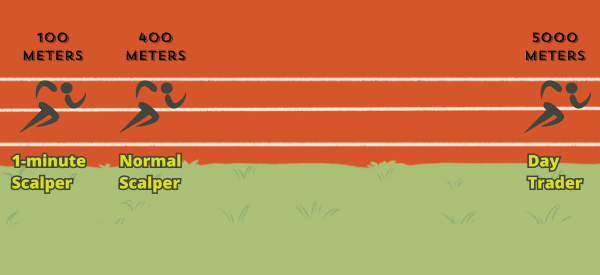

Trading approaches: An Overview
Before we get into scalping vs. day trading specifically, we must understand where they fit within the trading approach spectrum and the types of traders.
While all approaches combine technical analysis, insights, and risk management to make a profit from market dynamics, each trading approach is a unique lens through which traders interpret the market.
One key characteristic that sets them apart is the specific timeframe of buying, holding, and selling assets that each one implies. Here are the four typical approaches to trading.
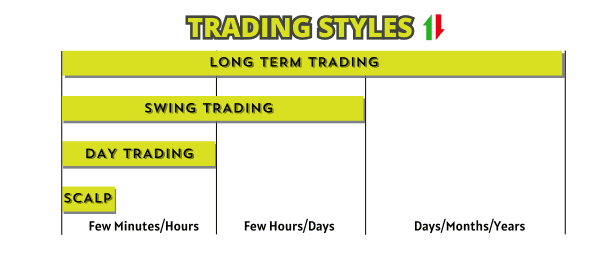

1. Fundamental Trading
Fundamental traders base their decisions on the underlying intrinsic value of assets, focusing on economic indicators, company financials, and industry trends.
They identify undervalued or overvalued securities, aiming to capitalize on discrepancies between market prices and fundamental values.
These traders often have a longer-term investment horizon and may hold positions for weeks, months, or even years, waiting for the market to reflect the true value of the assets they’ve identified.
2. Noise Trading
Unlike fundamental traders, noise traders may react intuitively to news headlines, rumors, or market sentiment. Call it a “gut feeling.”
Noise traders tend to trade impulsively based on short-term market fluctuations and random price movements. Holding periods range widely between traders based on the signals they are following.
While noise trading strategies may yield occasional profits, they often entail higher levels of risk and are susceptible to market volatility.
3. Sentiment Trading
These traders gauge market sentiment and investor psychology to anticipate future price movements.
They analyze indicators such as investor surveys, sentiment indexes, and social media sentiment to assess market sentiment trends.
Sentiment traders believe that shifts in market sentiment can precede changes in asset prices, allowing them to position themselves ahead of market movements.
They use momentum trading strategies based on their interpretation of prevailing sentiment indicators. Therefore, they might trade frequently in the short term or hold on to their positions longer.
4. Market Timing Trading
Market timers attempt to predict the direction of broader market trends and cycles, timing their entry and exit points to capitalize on anticipated market movements.
They may use technical analysis, economic indicators, and market breadth measures to assess market conditions and identify potential turning points.
Market timers may adopt bullish or bearish stances depending on their outlook for the economy and financial markets, adjusting their positions accordingly to align with their market timing forecasts.
The approaches above entail holding assets over several days, weeks, or months.
What Is Day Trading?
Day trading involves buying and selling financial instruments like stocks, options, and forex within the same trading day, with the goal of profiting from short-term price movements.
Day traders execute multiple trades throughout the day, closing all positions by the end of the trading session to avoid overnight exposure to market risk.
With this strategy, traders adopt a deliberate approach, assessing intraday price action, market trends, and fundamental factors (e.g, volatility, liquidity, trading volume, etc.) before executing trades.
Day traders exercise discipline and patience, waiting for favorable trading conditions to align with their strategies.
What Is Scalp Trading?
Scalp trading is a type of day trading that involves making rapid trades to profit from small price movements in highly liquid financial instruments. Traders aim to capitalize on short-term fluctuations in price, often holding positions for just minutes.
Traded commodities include stocks, forex pairs, futures contracts, and cryptocurrencies.
Scalp traders thrive in this high-speed environment, executing trades with split-second precision and exploiting fleeting price movements for quick profits.
Every second counts, and traders must make instantaneous decisions based on real-time market data.
As speed chess players sacrifice pieces to gain positional advantage, scalp traders may accept small losses to maintain their edge and capitalize on subsequent price movements.
Related » To scalp or not to scalp?
Scalping vs Day Trading: Key Similarities
Regardless of whether you’re playing regular or speed chess, the principles and goal of chess still hold.
Similarly, day trading and scalping share common concepts. They both:
- Allow profit from market volatility via small price movements.
- Apply to all stocks, currencies, bonds, and even exchange-traded funds.
- Don’t work with overnight positions.
- Involve multiple trades a day.
- Rely on technical analysis to make trading decisions.
- Use leverage to amplify returns (with increased risk).
- Require discipline and quick decision-making.
- Require daily monitoring of trading positions.
Ultimately, whether you’re aiming for rapid, incremental gains as a scalper or capturing daily trends as a day trader, the key lies in harnessing the volatility of the moment to achieve trading success.
Scalping vs Day Trading: Key Differences
You’ll likely lose a regular chess match if you try to move your pieces at breakneck speed. But in speed chess, you’ll run out the clock if you take too long pondering where your knight should gallop next.
In other words, you should know where scalping and day trading differ and where each strategy should be applied.
| Day trading | Scalping | |
| Entry and exit points | Hours. | Seconds or minutes. |
| Trading frequency | Low—a few per day. | High—hundreds per day. |
| Profit aim | Slightly larger profit potential on each trade. | Accumulate many small profits from multiple trades. |
| Management style | Active. | Intensive. |
| Charts used | Longer candlestick charts. | Shorter candlestick charts. |
While both scalping and day trading are short-term trading strategies, they differ in their time horizons and execution styles.
Understanding these distinctions is crucial for traders, especially as they look to choose a strategy that aligns with their preferences and risk tolerance in the fast-paced world of financial markets.
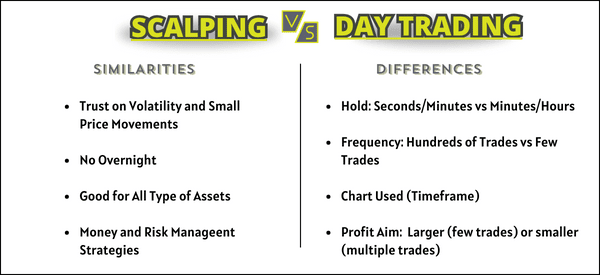

Day Trading and Scalping: Strategies To Note
Different day traders and scalpers use various approaches to day trade and scalp. Let us look at some of the most popular strategies you can use when you are a day trader.
As we’ve seen, scalping and day trading are similar in a few aspects. As such, many strategies are applicable to both, with the caveat that the time frames vary.
Let’s review some of the strategies for both.
Momentum Trading
Momentum trading involves identifying stocks or assets that show strong movement in one direction during the trading day.
You can leverage this strategy by entering a position early in the momentum and exiting for a profit once the movement begins to fade.
For example, a scalper might purchase a stock with a significant premarket upsurge, aiming to sell shortly after for a quick profit.
Similarly, this strategy applies to short selling when an asset displays a strong downward trend.
Volume-Weighted Average Price
The VWAP is a benchmark for both day traders and scalpers to make informed decisions. It’s calculated by dividing the total value traded (price multiplied by volume) by the total volume traded during a specified time, typically the trading day.
Traders might buy assets when their price is above the VWAP and sell when the price drops below. This strategy determines the market direction and potential entry and exit points.
VWAP bands, which are multiples of the standard deviation of VWAP, are used to identify potential support and resistance levels. Bands can also help traders gauge the degree of deviation from the average price and identify overbought or oversold conditions.
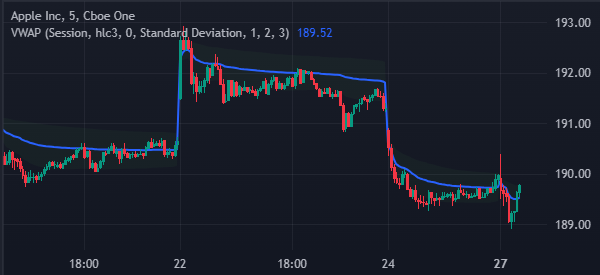

Reversals
Both day trading and scalping exploit reversal strategies, which involve identifying the potential end of a price trend and the beginning of a new one.
Traders use a mix of patterns and indicators to predict reversals:
- Head and shoulders pattern: Three peaks, with the middle peak (the “head”) being higher than the other two peaks (the “shoulders”). It forms after an uptrend and signals that the asset’s price may be transitioning from bullish to bearish.
- Double tops: When a price reaches a high point, drops, rallies again to the same level, and then declines once more, indicating a possible trend reversal.
- Hammer candlestick pattern: A candlestick with a small body and a long, lower wick, this signals a potential price reversal when it appears after a downtrend.
- Moving average convergence divergence (MACD) indicator: This compares short-term and long-term moving averages to identify potential changes in momentum.
This approach of finding reversals requires keen analysis to distinguish false reversals from genuine trend changes.
Continuations
In contrast to seeking reversals, some strategies focus on identifying continuation patterns, where an existing trend is expected to persist.
Bullish or bearish pennants, flags, and ascending or descending triangles are among the patterns used to predict continuations.
Breakouts
Breakout trading aims to enter a trade when an asset’s price moves outside a defined range or through a resistance level.
This could involve setting pending orders, such as buy stops or sell stops, to automatically execute trades when the price breaches predetermined levels.
Breakout strategies are based on the expectation that significant price movements follow these breaks, offering the potential for profit.
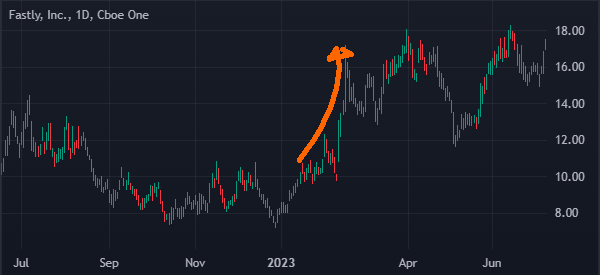

Stochastic Oscillator Indicator
The stochastic oscillator is a momentum indicator that compares a security’s closing price to its price range over a given period.
Traders use it to identify overbought and oversold conditions, potential trend reversals, and divergence between price and momentum, which can signal upcoming shifts in direction.
Moving Average Lines
Moving averages are used to identify trends, support and resistance levels, and potential entry and exit points.
Shorter-term moving averages (e.g., 9-period or 20-period) are popular among scalp traders, while day traders may use longer-term moving averages (e.g., 50-period or 200-period) to gauge the overall trend direction.
Parabolic SAR (Stop and Reverse)
Parabolic SAR is a trend-following indicator that helps traders identify potential entry and exit points.
It’s particularly useful for both scalp traders and day traders when trailing stops or determining reversal points in a trending market.
Relative Strength Index (RSI)
The RSI is a momentum oscillator that measures the speed and change of price movements. It helps traders identify overbought and oversold conditions and potential trend reversals.
By using RSI, scalp traders and day traders can confirm the strength of a trend, or anticipate potential turning points in price.
Fundamental Analysis
Specific to day trading, fundamental analysis evaluates the intrinsic value of a financial asset based on various economic, financial, and qualitative factors.
Day traders use it as a supplementary tool to understand the underlying factors driving daily price movements.
In scalping, this type of analysis isn’t necessary because of the shorter time frames of buying and selling.
Tape Reading
Unique to scalp trading, tape reading involves closely monitoring the time and sales data, level 2 quotes, and order flow to make rapid trading decisions based on real-time market dynamics.
Scalp traders using this strategy focus on very short-term price movements, often executing multiple trades within seconds or minutes.
Summary: Scapling vs Day Trading, which is better?
Within the rewarding world of trading, different strategies work for different people.
While some traders look for more intense, quick movements, others prefer to take a little more time to consider their options.
However you plan on trading to pursue short-term gains, discipline must be at the top of your game. To study, analyze, and decide, you must be astute and well-prepared.
Whatever your choice, we’re confident that we’ve given you a great head start in understanding these trading strategies for maximizing your chances of making a profit. So go ahead, make your move, and join Real Trading today.
External Useful Resources
- Scalping vs Day Trading – What is the Difference – Fxssi
